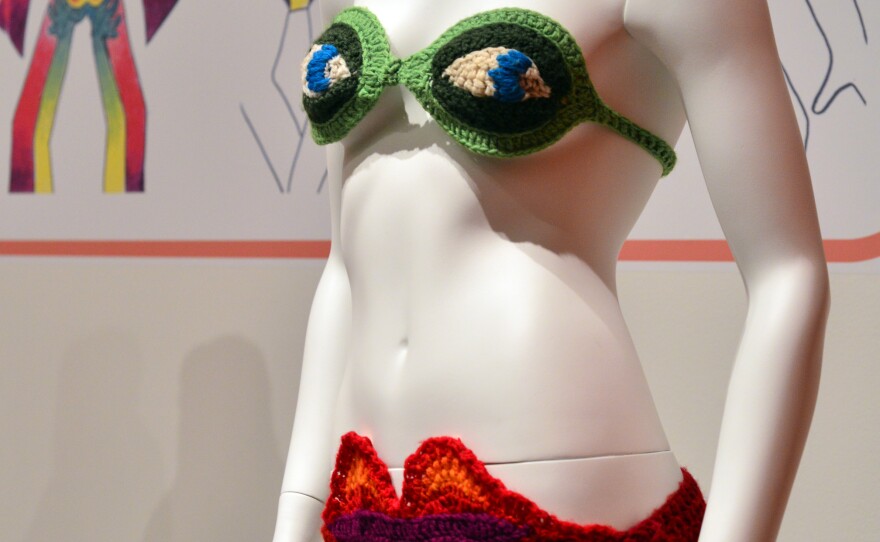Tie-dye. Macrame. Fringes and beads.
If you came of age in the 1960s, you’ll recognize these in the signature look of the era.
Maybe you turned your old jeans into a skirt, or embroidered colorful mandalas onto the back of a faded work shirt. In the 1960s and '70s, clothing was as much about personal expression as it was protection against the elements. But did you know you were creating art?
More on the arts Shiny New 'Nutcracker' Costumes Come To Life
Seattle designer Michael Cepress has gathered some of the era's most interesting fashions for a new exhibition at the Bellevue Arts Museum. “Counter Couture” includes what Cepress calls “the best and brightest of hippie fashions,” from beaded denim jackets to crocheted bikinis to tie-dyed shirts.
He traces his fascination with these clothes back to his teens. “I came across a book called 'Native Funk and Flash,' by Alexandra Jacopetti Hart,” Cepress explains. The book is an overview of what young counterculture fashionistas were doing in early 1970s. “Psychedelic embroidery, multimedia jewelry, wearable art of various forms.”
[asset-images[{"caption": "Seattle fashion and costume designer Michael Cepress curated Bellevue Arts Museum's exhibition \"Counter Couture.\"", "fid": "120584", "style": "placed_wide", "uri": "public://201509/20150917_couture1.1.jpg", "attribution": "Credit KUOW Photo/Gil Aegerter"}]]As a 15-year-old in the middle of Wisconsin, Cepress was into art and fashion and rock and roll. “Native Funk and Flash” served as an inspiration for the fashion and costume design career he eventually created for himself. Its photographs also served as his guides for locating the clothes he included in the Bellevue show.
“I have been on a journey to find these people, introduce myself, and literally on my hands and knees, digging in their basements, their attics, their trunks, to find these clothes!” he said.
And find them he did.
The first thing that hits you in the BAM galleries is color: vivid reds and oranges, purples and greens pulsate from capes and gowns, even shoes.
“Color is everything,” Cepress stresses. “When I pitched the project to the museum, I said I want museum guests to feel like they’re literally walking through the color spectrum.”
From a rainbow-hued cape that looks like a velvet bird costume, to a set of costumes that artist Salvador Dali commissioned for the opening of his museum in Spain, color is everywhere and inescapable. So are beads, fringe, fur and metal. The garments are wild and wacky; they are also familiar to denizens of the '60s.
A denim jacket, covered in spirals of multicolored crystal beads, metal studs, even a call bell, holds pride of place in one room. Created by an artist named Billy Shire, it won the 1974 Levis’ Denim Art Contest. For Cepress, this jacket epitomizes the flashy trends of the era.
Funk and flash converge in a mind-bending series of garments created by a crochet artist who goes by the name “100% Birgitta.” Apparently, Birgitta went everywhere with a bag of wool and her crochet hooks, constantly making new work. Her piece de resistance is an enormous bedspread that’s draped on a mannequin that stands 12 feet high. Cepress says Birgitta made it for Grateful Dead co-founder Bob Weir and his wife. Cepress calls it “a psychedelicized multicolor organic crochet masterpiece.”
[asset-images[{"caption": "King-sized bedspread crocheted by 100% Birgitta (Birgitta Bjerke) for Grateful Dead band member Bob Weir. This displays echoes a photo Birgitta had taken of herself modeling her creation.", "fid": "120585", "style": "placed_wide", "uri": "public://201509/20150917_couture14.jpg", "attribution": "Credit KUOW Photo/Gil Aegerter"}]]
Cepress has spent almost two years on this exhibition. “This is everything for me,” he says passionately. “It’s truly at the root of my vision and passion to be a designer.”
More than a professional inspiration, though, the fashions of this era were personally instructive for Cepress.
“As a period, this shows that the only limitations are the ones that we create for ourselves. As an artist, that’s become my mantra.”
Michael Cepress’ show, “Counter Couture,” is at the Bellevue Arts Museum until January 2016.











